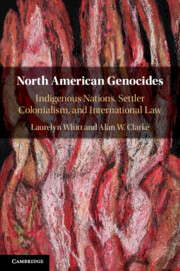Book contents
- North American Genocides
- North American Genocides
- Copyright page
- Dedication
- Epigraph
- Contents
- Preface
- Acknowledgments
- Introduction
- Chapter 1 North American Genocide Denial
- Chapter 2 The Legal Case for North American Genocides: a Retrospective Methodology
- Chapter 3 Settler Colonialism and Indigenous Nations
- Chapter 4 A Legal Primer for Settler Colonial Genocides
- Chapter 5 The Beothuk Nation (1500–1830)
- Chapter 6 The Powhatan Tsenacommacah (1607–1677)
- Chapter 7 The Conventional Account of Genocide: from a Restrictive to an Expansive Interpretation
- Chapter 8 Toward an Account of Systemic Genocide
- Appendix Convention on the Prevention and Punishment of the Crime of Genocide
- Index
Chapter 2 - The Legal Case for North American Genocides: a Retrospective Methodology
Published online by Cambridge University Press: 12 July 2019
- North American Genocides
- North American Genocides
- Copyright page
- Dedication
- Epigraph
- Contents
- Preface
- Acknowledgments
- Introduction
- Chapter 1 North American Genocide Denial
- Chapter 2 The Legal Case for North American Genocides: a Retrospective Methodology
- Chapter 3 Settler Colonialism and Indigenous Nations
- Chapter 4 A Legal Primer for Settler Colonial Genocides
- Chapter 5 The Beothuk Nation (1500–1830)
- Chapter 6 The Powhatan Tsenacommacah (1607–1677)
- Chapter 7 The Conventional Account of Genocide: from a Restrictive to an Expansive Interpretation
- Chapter 8 Toward an Account of Systemic Genocide
- Appendix Convention on the Prevention and Punishment of the Crime of Genocide
- Index
Summary
When, how and why might the term genocide appropriately be ascribed to the experience of North American Indigenous Nations? This chapter examines the propriety of using the modern concept of genocide to evaluate centuries-old conduct. There are those who argue that moral or legal concepts cannot properly apply to an earlier era, that we cannot evaluate the actions of an earlier time by reference to moral or legal principles not then accepted or even in existence. This latter notion is deployed not simply to undermine any moral judgment of the past; it suggests that we now reside on a formally level playing field and that modern society cannot (or should not) redress past wrongs. Furthermore, there are those, mentioned in Chapter 1, who argue that what happened to Indigenous Nations in North America, was not genocide. Such arguments often proceed from a variety of mistaken notions about genocide. Some have argued that genocide must be limited to the Holocaust or Holocaust-like events. Others deny that the mental element of genocidal intent can be met. Still others argue that genocide cannot occur unless there is a specific governmental policy behind the atrocities, while others blame germs, or other factors for the demographic collapse of Indigenous North Americans. We argue throughout this book that these claims are false; if we are to move toward justice in the present and future, judgments about past wrongs can and must be made.
- Type
- Chapter
- Information
- North American GenocidesIndigenous Nations, Settler Colonialism, and International Law, pp. 26 - 43Publisher: Cambridge University PressPrint publication year: 2019

